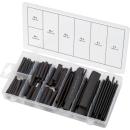Heat-shrinkable bodywork tubing

Heat-shrinkable tubing for car bodies
︾
Using heat-shrink tubing for bodywork :
Heat shrink tubing is polymer tubing which, when heated, shrinks to form an insulating layer around an object. Shrink tubing is used in a variety of bodywork applications, offering benefits such as protection, insulation and aesthetic finish. Here are some common uses for heat-shrink tubing in bodywork:
Protection of electrical cables and harnesses:
Heat shrink tubing is widely used to wrap and protect electrical cables and harnesses in vehicles. This helps prevent wear, abrasion and exposure to the elements, improving the durability and reliability of electrical components.
Insulation of electrical connections:
When electrical connections need to be insulated and protected from moisture, heat shrink tubing offers an effective solution. When heated, they contract tightly around the connections, creating an impermeable barrier.
Repairing harnesses :
In the event of damage to electrical harnesses or cables, heat shrink tubing can be used to repair and reinforce damaged areas. They provide additional insulation and mechanical protection.
Weld reinforcement :
Exposed welds can be reinforced with heat shrink tubing, offering protection against oxidation, corrosion, and external influences that could affect the quality of the connection.
Protection of pipes and ducts:
In some applications, heat shrink tubing can be used to wrap and protect pipes or conduits, contributing to better resistance to weather, chemicals, and impacts.
Repairing coatings :
In the case of minor bodywork damage, heat shrink tubing can be used to repair plastic coatings, creating a protective layer and minimising the appearance of imperfections.
Identification and marking :
Heat shrink tubing can be used to mark and identify specific cables or components. They can be made in a variety of colours, and labels can be applied before shrinking to indicate important information.
Aesthetic finish:
In addition to their functional properties, heat shrink tubing often offers a clean and professional aesthetic finish. They allow cables to be grouped and organised in an orderly fashion, giving a neat overall appearance.
The use of heat shrink tubing in automotive bodywork therefore helps to improve the reliability, durability, electrical safety and aesthetic appearance of components, making it a versatile choice for a variety of applications.
Characteristics of heat-shrinkable tubing for bodywork :
Professional grade heat shrink tubing, regardless of manufacturer, is generally characterised by the following:
High-quality materials :
Professional-quality heat-shrink tubing is made from high-quality materials, often specific polymers such as polyolefin.polymers such as polyolefin, ensuring resistance to heat, abrasion and durability.
Weather and chemical resistance:
They offer effective protection against external influences such as moisture, dust, chemicals and UV. This makes them suitable for automotive applications where robust protection is required.
Uniform shrinkage:
Professional heat shrink tubing has uniform, controlled shrinkage when heated. This ensures complete coverage and a tight fit around the objects to be protected.
Temperature range:
These tubes are designed to operate over a wide temperature range, ensuring reliable performance in a variety of environmental conditions.
Variety of sizes and colours:
Professional shrink tubing assortments often offer a variety of sizes and colours to suit different applications and allow visual organisation.
Easy to use:
Professional heat shrink tubing is generally easy to use. The application of heat, often with a hot air gun, causes shrinkage, offering quick and efficient installation.
Safety standards:
These products often comply with industry safety standards and regulations, ensuring safe and reliable use.
FAQs on the use of heat-shrink tubing in bodywork :
Questions from users about the use of heat-shrink tubing in bodywork often reflect a desire to understand how these components can be effectively integrated into automotive repair and maintenance work. Here are some common questions and professional answers that could be provided:
Question 1: Why should I use heat shrink tubing in bodywork?
Heat shrink tubing provides essential protection and insulation in the bodywork industry. They help prevent wear and abrasion, and protect cables and connections from moisture and external influences. By repairing wiring harnesses, insulating connections or reinforcing welds, heat-shrink tubing contributes to the durability and reliability of components.
Question 2: How do I choose the right size of heat-shrink tubing?
It's crucial to choose the right size of tubing for the diameter of the object to be wrapped. Carefully measure the diameter of your cable, electrical harness or component, then choose a heat-shrink tubing with a slightly larger initial diameter to allow for the appropriate shrinkage.
Question 3: What is the recommended installation method for bodywork heat-shrink tubing?
Heat-shrink tubing is generally installed using a hot air gun. Apply uniform, controlled heat to the tubing, ensuring that the area to be protected is completely covered. Make sure the sleeve shrinks evenly to give a clean, effective finish.
Question 4: Is heat-shrink tubing resistant to external conditions?
Yes, heat-shrink tubing is designed to withstand outdoor conditions. They offer protection against moisture, dust, chemicals and UV rays, making them ideal for automotive bodywork applications where robust protection is required.
Question 5: Can heat-shrink tubing be used to repair damaged plastic coatings?
Yes, heat shrink tubing can be used to repair damaged plastic coatings, providing an extra layer of protection. This can help minimise the appearance of imperfections and extend the life of the coating.
These answers are intended to provide basic information on the use of heat shrink tubing in bodywork.
